Abstract
Global cement manufacturing generated 1.6 billion metric tons of CO2 in 2022 and relies heavily on non-renewable raw materials. Utilizing agro-industrial waste as supplementary cementitious material (SCM) can help mitigate the demand for these resources. SCMs have been integrated into cement production to deliver both technical and environmental benefits to mortars and concrete. This study examines mortar blends containing blast furnace slag (BFS), Brazilian calcined clay (BCC), and bamboo leaf ash (BLA). While BFS and BCC are already established in the cement industry, recent research has highlighted BLA as a promising pozzolanic material. The SCMs were characterized, and mortars were produced to assess their flexural and compressive strength, as well as durability indicators such as electrical resistivity, chloride diffusion, migration coefficient, and carbonation resistance. The findings reveal significant performance enhancements. Partial cement replacement (20% and 40%) maintained the strength of both binary and ternary mortars, demonstrating statistical equivalence to the reference mortar (p > 0.05). It also contributed to an improved pore structure, reducing the migration coefficient by up to four times in the 20BLA20BCC mix (which replaces 20% of cement with BLA and 20% with BCC) compared to the reference mix. Chemically, the SCMs enhanced the chloride-binding capacity of the cementitious matrix by up to seven times in the case of the 20BCC mortar, thereby improving its durability. Therefore, all tested compositions—binary and ternary—showed mechanical and durability advantages over the reference while also contributing to the reduction in environmental impacts associated with the cement industry.
1. Introduction
Industrial waste, byproducts, and co-products with pozzolanic and hydraulic properties are highly utilized in cement manufacturing worldwide. Several compelling reasons support this practice: First, pozzolanic materials have characteristics that can enhance the properties of cementitious materials, such as strength, durability, and reduced permeability [1]. Second, the cement industry is a significant source of greenhouse gas emissions [2], and utilizing waste materials contributes to a lower environmental impact [3,4]. Finally, incorporating previously considered waste materials can enhance profitability and enable the production of more cost-effective products [5].
Blast-furnace slag (BFS) is a well-researched material widely utilized in the cement industry, although its availability is somewhat restricted [6]. BFS is employed in various countries due to its unique ability to enhance chloride resistance, reduce CO2 emissions by 48%, lower energy consumption by 37%, and achieve cost savings of 16.28% [4]. Additionally, materials such as Brazilian calcined clay (BCC) and agro-industrial ashes have been recently assessed and implemented globally in countries like India, Cuba, and Panama [7]. In countries where blended cement is predominantly utilized, the CO2 emissions per ton of cement produced are significantly lower [8].
Numerous studies conducted over the past decade have highlighted the exceptional physical and mechanical properties of composites that incorporate calcined clay. Research by Xuan et al. (2022) revealed a significant improvement in compressive strength with the addition of calcinated clay [9]. The study indicated that the inclusion of BCC enhanced compaction properties and resulted in increased specific gravity [10]. Given that clay is abundantly available in the Earth’s crust, it presents substantial potential as a viable short-term option for partially replacing clinker on a global scale [11,12]. However, clays with optimal composition are currently being utilized by other industries, such as paper manufacturing and ceramics, as adsorbents for various molecules and particles. This has led to price increases and a reduction in supply.
Blast furnace slag (BFS) is an important byproduct of the steel manufacturing sector, formed at high temperatures (typically between 900 °C and 1200 °C) from silica, a common impurity in iron ores and limestones. The use of BFS in concrete reduces the need for high cement content, thereby lowering CO2 emissions associated with the cement industry. Additionally, BFS enhances mechanical properties, particularly by facilitating the formation of C-A-S-H gel, which improves resistance to chloride attack. Chlorides can lead to pitting corrosion in the steel reinforcements of structures. Concrete incorporating BFS shows significantly better resistance to the diffusion of mobile chloride compared to ordinary Portland cement (OPC). Although high levels of BFS (60–80 wt.%) may result in reduced compressive strength during the early curing stages (2–7 days), a notable increase in strength is typically observed at 28 days, reaching its maximum at 90 days [13]. Moreover, concrete with lower cement content and BFS demonstrates superior resistance to sulfates and seawater compared to concrete with ordinary Portland cement (OPC) [14,15].
Agro-industrial wastes are increasingly being utilized as biomass for energy generation, yielding ashes as a byproduct. Certain ashes with a high silica content have been identified as supplementary cementitious material (SCM). Notably, bamboo leaf ash (BLA) has been shown to enhance the physical and mechanical properties of cementitious materials when used as a partial replacement for cement derived from agro-industrial waste. Silva et al. (2021) [16] investigated the pozzolanic characteristics of BLA using the Chapelle method and found that the ash demonstrates outstanding pozzolanic behavior. Papers show that it exhibits excellent pozzolanic behavior. Research indicates that mechanical strength can be maintained or even improved with high levels of cement replacement by BLA, specifically at 30% [16,17]. Moreover, replacing 30% of cement with BLA can lead to a 23.71% reduction in the production cost of mortars and a 28% decrease in embodied energy [16]. One effective approach is to employ a combination of various materials, such as ternary binders, to address challenges related to the availability and cost of suitable pozzolanic materials, as well as environmental concerns. Rodier et al., 2019 [2] noted a scarcity of studies on ternary binders that incorporate agro-industrial wastes. Similarly, Villar-Cociña et al., 2021 [18] observed an increase in research over the past decade on innovative cement formulations that utilize multiple supplementary cementitious materials.
In this context, the present study explores the combined application of blast furnace slag (BFS), Brazilian calcined clay (BCC), and bamboo leaf ash (BLA) in the formulation of low-cement mortars. The primary objective is to evaluate the mechanical and durability properties of these ternary blends and assess their viability as sustainable alternatives to ordinary Portland cement-based materials.
2. Materials and Methods
The Portland cement used was CEM I 42.5R, classified according to the European standard EN 197-1:2011 [19]. A portion of the cement was replaced with BFS, BLA, and BCC materials. The BFS, or Blast Furnace Slag, is a hydraulic and pozzolanic byproduct from a steel mill located in northern Spain. It is generated during the reduction of iron ores by cokes in a blast furnace at temperatures ranging from 1350 °C to 1550 °C. Its reactivity and hydration kinetics typically depend on the glass content, which is influenced by the cooling cycle. Rapid water-quenching often results in an over 90% amorphous vitreous phase due to this swift cooling process, as well as the fine particle size achieved after milling. The bamboo leaves were collected in the municipality of Presidente Prudente, São Paulo State, Brazil, and the resultant ash was produced through an auto-combustion process in a furnace lacking temperature control. The BCC was provided by a cement plant in Brasília, Brazil, and is utilized in the production of cement compounds (specifically, the Brazilian cement type CPII-Z). For superplasticization, Viscocrete 20HE (Sika S.A., Madrid, Spain) was used; this additive is a polycarboxylate polymer-based material with a density of 1.09 g/cm3.
2.1. Characterization of Partial Replacement
A comprehensive chemical analysis of the principal oxides was conducted using X-ray fluorescence (XRF) with a Bruker model S2 Ranger. Laser granulometry was employed to evaluate the particle size distribution, utilizing a Mastersizer 3000, from Malvern Panalytical, Worcestershire, UK. The Specific Surface Area was determined through the Brunauer–Emmett–Teller (BET) method with a Monosorb Surface Area Analyzer MS-13 from Quantachrome instruments, Odelzhausen, Germany. Additionally, to assess the mineralogy of the material, X-ray diffraction (XRD) analysis was conducted using a D8 Advance instrument, from Bruker, Billerica, MA, USA, with diffractogram records collected across a 2θ range of 5° to 55°.
Table 1 shows the chemical composition of Ordinary Portland Cement type I (42.5R) and the other binders used in the research.

Table 1.
Oxide composition of binders (% wt.).
The chemical composition limit values for pozzolanic materials are specified in ASTM C618 [20]. According to this standard, the combined percentage of SiO2, Al2O3, and Fe2O3 must exceed 70%. The SiO2 + Al2O3 + Fe2O3 content in BLA and BCC was measured at 77.59% and 91.49%, respectively, both surpassing the minimum requirement of 70%. In both materials, silica emerged as the most dominant component. Another critical parameter is the concentration of SO3, as this compound can contribute to internal cracking in cementitious composites [21]. The limit for SO3 is set at 4% [20], and the BLA and BCC samples exhibited values of 2.14% and 1.48%, respectively.
In the case of BFS, it is essential to consider it as a cementitious material with a composition that falls within specific ranges: CaO (30–45%), SiO2 (30–48%), Al2O3 (15–25%), and Fe2O3 (0.5–2%) [22]. While the BFS utilized in this study does not fully meet all the oxide requirements, the primary oxides, CaO and SiO2, are within the acceptable range.
Figure 1 illustrates the particle size distributions of materials used for partial cement replacement. The granulometry of BFS and BCC was measured as received, while the granulometry of BLA was obtained after milling for 50 min.
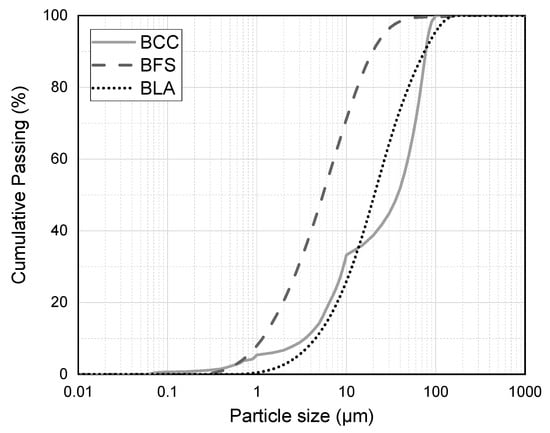
Figure 1.
Particle size distribution of the BFS, BLA, and BCC.
The laser diffraction analysis of particle size distribution for the BCC, BFS, and BLA (Figure 1) revealed a D50 of 20.33 μm, 6.21 μm, and 20.6 μm, along with D90 values of 56.59 μm, 22.5 μm, and 74.8 μm, respectively. Chen et al. (2021) [23] examined the particle size distribution of CEM I 52.5 R and observed that up to 95% of the particles fell within the 1 μm and 40 μm range. A physical criterion established by ASTM C618 pertains to the fineness of pozzolanic materials, indicating that a minimum of 34% must be retained on the 45 μm sieve. As shown in Figure 1, only the BCC exhibits a granulometric distribution that does not comply with the normative standards. The fineness of the ash particles contributes significantly to enhanced pozzolanic activity, leading to the formation of additional hydrated calcium silicate (CSH) [24].
Typically, an inverse relationship is expected between specific surface area (SSA) and particle size, underscoring the importance of analyzing both parameters together. The SSA values for BFS, BLA, and BCC are 1.77 m2/g, 12.90 m2/g, and 13.98 m2/g, respectively. In comparison, the SSA of cement is recorded at 1.16 m2/g [23].
Figure 2 illustrates the XRD pattern corresponding to the analyzed bamboo leaf ash, Brazilian calcined clay, and blast furnace slag.
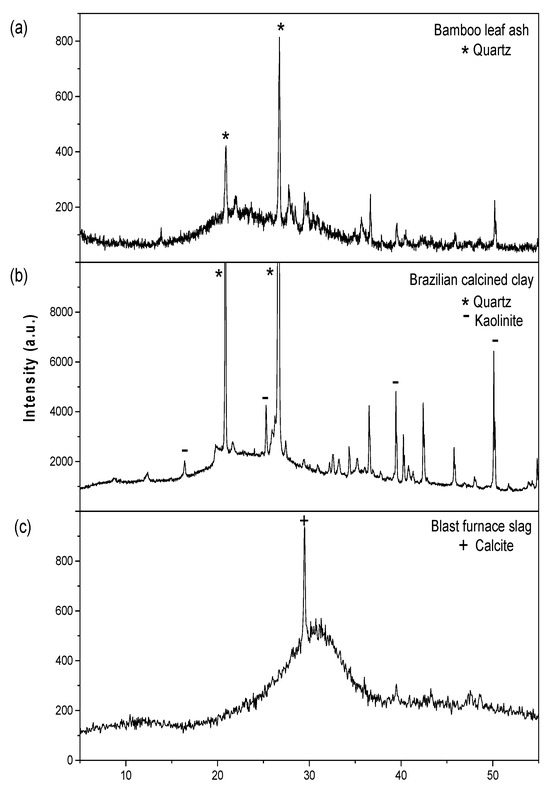
Figure 2.
X-ray diffractograms of (a) bamboo leaf ash, (b) Brazilian calcined clay, and (c) blast furnace slag.
The three binders exhibited an amorphous nature, corresponding to the broadband between 15° and 40° 2θ. These data suggest that the material can be analyzed for incorporation into cementitious composites to modify their properties and contribute to environmental conservation.
Quartz is the primary compound found in bamboo leaf ash (BLA). The optimal temperature range for producing BLA with minimized vitreous phases is between 500 °C and 600 °C [25]. However, the BLA used in this study was produced using the auto-combustion method without temperature control. The XRD pattern of Brazilian calcined clay reveals pronounced quartz peaks alongside the presence of kaolinite, which is typically associated with non-calcined materials. Figure 2c illustrates the X-ray diffractograms of blast furnace slag (BFS), identifying calcite as a mineralogical phase. The typical XRD pattern and the key mineralogical phases present in vitreous BFS have been documented in the literature [26] and align with the findings of this research.
2.2. Mortar Tests
The composition of the mortar mixture was established following UNE 196-1 [27], utilizing standardized sand from Normensand® GmbH, D-59269, Belgium, Germany, along with distilled water. The sand exhibited a fineness modulus (FM) of 2.93, water absorption of less than 0.2%, and was of 100% purity. The particle size distribution is detailed in Table 2.

Table 2.
Quartz sand granulometric distribution.
The reference (REF) mortar, along with several mortar mixtures, was produced using partial cement replacement, specifically 20% BFS, 20% BLA, and 20% BCC. Additionally, ternary blended cement consisting of 20% BFS + 20% BLA, 20% BFS + 20% BCC, and 20% BLA + 20% BCC was created, as detailed in Table 3, utilizing a water/solids ratio of 0.5.

Table 3.
Mix the proportions for producing mortar samples.
The selection of cement replacement levels in this study was informed by previous research on the pozzolanic potential of bamboo leaf ash (BLA). Several studies have indicated that BLA can effectively substitute for cement at levels of up to 20% without significantly compromising compressive strength [2,28]. In some instances, replacement levels as high as 30% have resulted in compressive strengths that are statistically comparable to those of control mixtures without BLA [16,17]. Given this evidence and considering that blast furnace slag (BFS) is commonly utilized at higher replacement ratios—up to 95% in the production of type III cements [19]—we chose to extend the substitution level in some mixes to 40%, particularly when combining BLA with BFS and calcined clay. This strategy enabled the assessment of the individual contribution of each supplementary cementitious material (SCM) and explored their potential synergistic effects at elevated replacement levels. To maintain consistent workability across the various mortars without altering the water-to-binder ratio as specified in EN 934-2 [29], we used the superplasticizer Viscocrete 20HE from Sika, Madrid, España.
The mortars were manufactured using prismatic molds with dimensions 160 × 40 × 40 mm and were cured in a climatic-controlled chamber maintained at a constant temperature of 20 ± 1 °C and a relative humidity of 98% for periods of 7 and 28 days, respectively. The mechanical compressive strength was then evaluated in accordance with the applicable European Standard EN 196-1 [27]. Compressive strength was assessed for each composition using the two halves of the specimens derived from flexural tests. The flexural tests were conducted at a loading rate of 50 ± 10 N/s, while compressive strength tests were performed at a loading rate of 2400 N/s. Data on compressive strength were statistically analyzed using the Origin 8.5 software (OriginLab Corporation, Northampton, MA, USA). The normality of the data was verified using the Shapiro–Wilk test, and a one-way analysis of variance (ANOVA) was used to analyze the compressive strength of mortars. Differences were considered statistically significant at p < 0.05.
The same molds were used for measuring electrical resistivity from the demolding process through 28 days of curing. Measurements were performed using the RCON device from Giatec Scientific (Ottawa, ON, Canada) [30]. Electrical resistivity is a key property of materials, indicating their ability to resist the flow of electrical current. In cementitious composites, electrical resistivity is closely linked to connected porosity, as the movement of ions primarily occurs in the aqueous phase. Consequently, the electrical resistivity values provide valuable insights into interconnected porosity, which can indicate the material’s susceptibility to the infiltration of aggressive agents, such as chlorides. This aspect is especially significant at early ages, as reported in the literature [31], and the method is non-destructive.
The test procedures for determining non-steady-state chloride migration coefficients are outlined in NT BUILD 492 [32]. For this test, cylindrical specimens with a diameter of 100 mm and a thickness of 50 mm, which had been cured for 28 days, were used. Before testing, the specimens were saturated and positioned to ensure that the lower part of the sample was immersed in a cathodic solution containing 10 wt.% NaCl. The anodic solution was prepared by mixing 500 mL of 0.3 M sodium hydroxide (NaOH) and was applied to the upper surface of the specimen. An external voltage was then applied, facilitating the movement of chloride ions through the liquid-filled pores.
Chloride diffusion tests were conducted to assess the free chloride content following RILEM TC178-TMC [33] and total chloride content based on UNE 14629 [34]. The chloride diffusion coefficient was estimated following the guidelines of NT BUILD 443 [35]. For this evaluation, cylindrical mortar specimens with a diameter and a length of 100 mm. The mortars were immersed in a 165 g/L NaCl solution for a duration of up to 35 days. We measured the percentage of chlorides by titrating with a silver nitrate solution (AgNO3) using an automatic potentiometer titrator (916 Ti-Touch by Metrohm).
The procedure outlined in UNE 12390-12 [36] was employed to assess the carbonation resistance of composite mortars using an accelerated method. The molds used were cylindrical, measuring 100 mm in diameter and 100 mm in length. Each cylinder is divided into two halves, each 50 mm in diameter, which are used to measure the depth of carbonation after a 28-day curing period. This includes 14 days of preconditioning at room temperature (21.5 °C ± 3.5 °C) and humidity (57.5% ± 7.5%), followed by an exposure period of 7, 28, and 70 days in a curing chamber with a carbon dioxide concentration of 3%. Once removed from the carbonation chamber, the specimens were split into two parts, and the fracture surface was treated with a phenolphthalein solution. This solution was used to visually differentiate the carbonated area, allowing for the measurement of the carbonation depth (dk). The phenolphthalein changes color within a pH range of 8 to 9.2; it shows an intense fuchsia hue for higher pH values exceeding 9.2, while areas below this range remain uncolored. With the carbonation depth (dk) established, the carbonation speed (KAC) is calculated using an equation based on Fick’s Law, as outlined in Standard EN 12390-12 [36]. Fick’s Law describes diffusion processes where equilibrium is not achieved.
3. Results and Discussion
3.1. Mortar Tests
3.1.1. Flexural Strength
Figure 3 illustrates the average and standard deviation (SD) of the flexural strength of all tested mortars at 7 and 28 days.
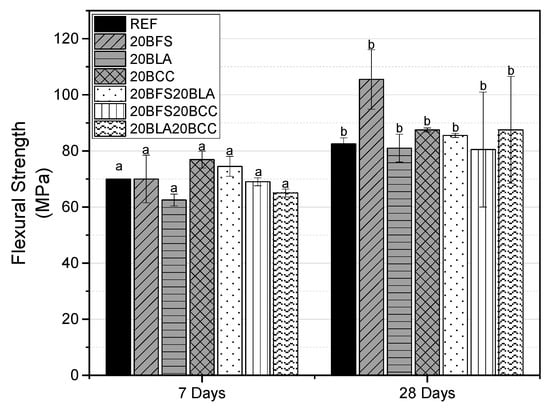
Figure 3.
Flexural strength of specimens according to curing time. Different letters denote significant statistical differences (p < 0.05, ANOVA, Tukey test).
At both 7 and 28 days of curing, all mortar mixes exhibited statistically equivalent flexural strength within each curing period. Notably, at 28 days, the mixture containing 20% blast furnace slag (BFS) showed significance, achieving a flexural strength that was 28% higher than that of the reference mortar. This finding highlights the potential of BFS as a highly effective supplementary material for partial cement replacement, contributing to the development of mechanical strength over time.
When examining flexural strength alone, the results suggest that the proposed cement replacements do not compromise the mechanical performance of the mortars. These findings underscore the technical viability of sustainable mixtures for applications where both durability and mechanical strength are essential requirements.
3.1.2. Compressive Strength
Figure 4 illustrates the average and standard deviation (SD) of the compressive strength of all tested mortars at both 7 and 28 days.
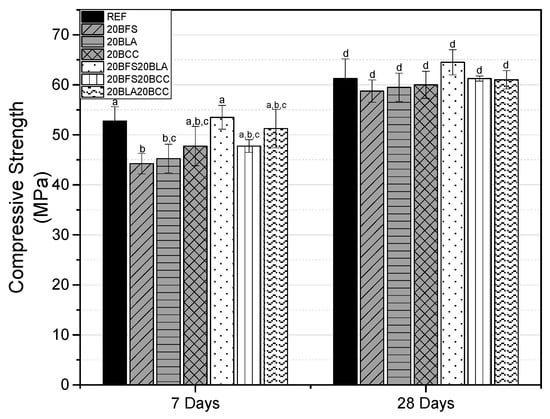
Figure 4.
Compressive strength of specimens corresponding to curing time. Different letters denote significant statistical differences (p < 0.05, ANOVA, Tukey test).
After 7 days of curing, the reference mortar exhibits compressive strength values that are 9.48%, 19.20%, and 16.57% higher than those of the 20BCC, 20BFS, and 20BLA mortars, respectively. While it is anticipated that the reference mortar will perform better than composite mortars during this period due to the slower pace of the pozzolanic reaction in comparison to the hydration of pure Portland cement, the mechanical characterization results indicate that all binary and ternary blends exhibit excellent performance, even at early curing ages such as 7 days.
Previous studies on the combinations of pozzolan and cement corroborate these findings. For instance, research conducted by Abebaw, Bewket, and Getahun demonstrated that partial replacement of cement with BLA in concrete production resulted in a reduction in compressive strength at 28 days of curing. However, this was followed by an increase in strength at 56 days [37].
Ternary compositions that incorporate 40 wt.% cement replacement with BFS, BLA, and BCC demonstrate mechanical properties that are comparable to the reference mix or slightly superior, as observed in the 20BFS20BLA blend, which exhibits 5.3% improvement. Consistent with previous studies, the level of cement replacement achieved with combined pozzolans surpasses that of individual blends with cement [37]. Research conducted by Gyurkó and Nemes indicates that, from an environmental perspective, SCMs offer greater advantages without significantly impacting the performance of the mix [38].
Several studies have highlighted the synergistic effects of blast furnace slag (BFS), metakaolin (a calcined clay derived from the calcination of kaolin), and various supplementary cementitious materials (SCMs). The beneficial synergistic effects of SCMs play distinct roles throughout the entire lifespan of the composite [39]. Research conducted by Sujjavanich et al. (2017) [39] indicates that the interaction between metakaolin and fly ash significantly enhances the microstructure density and overall performance of hardened concrete. Additionally, the work of Khatib and Hibbert [40] demonstrates the synergistic effect of BFS and metakaolin, which improves strength at both early and long stages.
Adem and Cherkos [41] conducted a study on concrete formulated with ternary binders, where cement was partially replaced with 5% or 10% pumice powder (PP) and blast furnace slag (BLA). The authors observed that a replacement level of up to 15% (comprising 10% PP + 5% BLA) yielded compressive strength comparable to that of the reference sample. They attributed the decline in strength at higher replacement levels to a decrease in the concentration of reactive crystalline silica.
3.1.3. Electrical Resistivity of Mortars
Figure 5 presents the electrical resistivity measurement of the tested mortars over a period of 28 days. Electrical resistivity is correlated with interconnected porosity; consequently, higher electrical resistivity indicates a more densely packed microstructure characterized by lower interconnected porosity. This functional relationship is associated with enhanced durability, as many aggressive agents, such as chlorides and sulfates, penetrate the microstructure through the aqueous phase [42].

Figure 5.
Changes in the resistivity of cement mortar throughout the test.
The growth in resistivity is a result of the hydration process of binders and a possible porosity-filling effect that increases the resistance to the transport of electrical energy by the specimen. The increased electrical resistivity indicates a denser cement matrix [43].
It can be observed that the reference mortar exhibits an electrical resistivity of 44.2 Ω·m after 28 days of curing. The compound mortars containing 20% of BFS, BLA, and BCC display resistivity values of 60.67 Ω·m, 114.35 Ω·m, and 106 Ω·m, respectively. Among the ternary binder compositions, the highest results were achieved by 20BFS20BLA, 20BLA20BCC, and 20BFS20BCC with values of 190 Ω·m, 177 Ω·m, and 131 Ω·m. Both the reference and 20BFS samples indicate a clear trend toward a stable electrical resistivity value from the early stages of curing. In contrast, the other binary and ternary compositions studied exhibit a continuous increase in this property as the curing process ages, suggesting a progression toward greater closure of porosity and a reduction in interconnected porosity.
The electrical resistivity of compound mortars incorporating metakaolin and nanosilica, as well as their ternary mixes, was examined by García et al. (2020) [31]. The authors observed that the ternary mixes demonstrated a more rapid increase in electrical resistivity. These findings are very similar to those found in this research. Garcia et al. (2020) [31] concluded that the combination of nanosilica and metakaolin yields a beneficial effect.
The estimation of chloride diffusion based on electrical resistivity is outlined by Sanjuán et al. (2018) [44]. Resistivity values below 50 Ω·m indicate high chloride diffusion, while values between 50 Ω·m and 100 Ω·m suggest moderate diffusion. Resistivities ranging from 100 Ω·m to 200 Ω·m imply low diffusion, those between 200 Ω·m and 2000 Ω·m indicate very low diffusion and resistivities exceeding 2000 Ω·m imply insignificant chloride diffusion. According to these classifications, the reference mortar is expected to exhibit high chloride diffusion, 20BFS demonstrates moderate diffusion, and the other samples show low chloride diffusion.
3.1.4. Chloride Migration
During the test, chloride ions are transmitted through the mortar sample under an applied voltage. Subsequently, the sample is treated with AgNO3, allowing for the measurement of chloride penetration depth, as illustrated in Figure 6. This depth is then utilized to calculate the chloride migration coefficients, which are also presented in Figure 7.
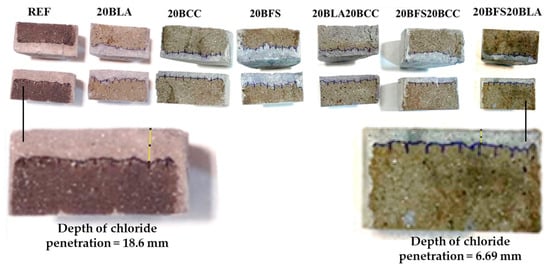
Figure 6.
Chloride penetration depth in mortars tested. The light region corresponds to the chloride penetration profile of the AgCl precipitate, which is revealed when the sample is sprayed with AgNO3).
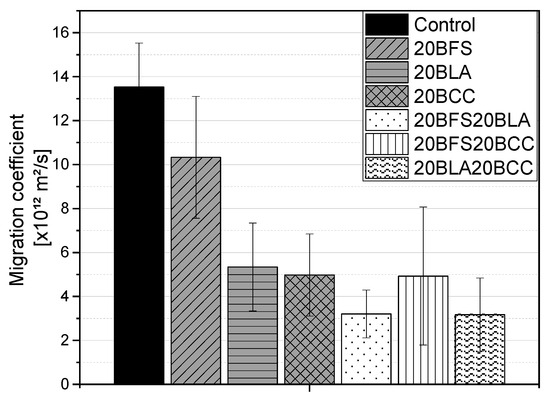
Figure 7.
Chloride migration test results (NT Build 492).
Migration coefficients varied between 3.17 × 10−12 m2/s and 13.53 × 10−12 m2/s for both the reference mix and the cement replacement mortars. The lowest coefficient value was observed in the 20BLA20BCC and 20BFS20BLA mortars, while the highest was recorded in the REF mortar. These findings are consistent with the electrical resistivity characterization, as the mixes exhibiting the lowest migration coefficients demonstrated the highest electrical resistivity values. This behavior confirms a synergy between BFS and BLA, corroborated by both mechanical testing and electrical resistivity analysis (Figure 2 and Figure 3).
The composite mixes demonstrate a lower migration coefficient compared to the REF mortar. Among the binary systems, the BCC achieved the best results, closely followed by the BLA, while the BFS blend exhibited significantly poorer chloride migration behavior. Other researchers have also observed a notable reduction in the migration coefficient as the BFS content increases [45]. Utilizing mineral admixture can enhance the distribution of pore size and shape within the composite, as more C-S-H and C-A-S-H gels are formed during the hydration of pozzolanic materials [2]. Additionally, in separate studies, concrete containing PP and BLA exhibited a reduced tendency to absorb water, which the authors attributed to the initial filling of gaps by alternative binders that act as a barrier against water penetration [43].
Maes, Gruyaert, and De Belie (2013) [46] investigated the use of BFS as a cement replacement at levels of 50%, 70%, and 85%. In general, they observed that the migration coefficients of compound concrete are lower than those of the reference, with up to 70% replacement.
3.1.5. Chloride Diffusion
Figure 8 illustrates the effective chloride transport coefficient (De), the apparent chloride transport coefficient (Da), and the surface concentrations (Cs).
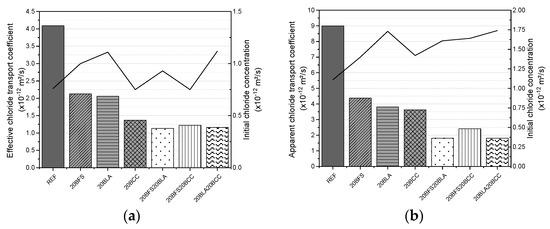
Figure 8.
(a) Effective chloride transport coefficient and initial free chloride concentration. (b) Apparent chloride transport coefficient and initial total chloride concentration in samples.
Figure 8 illustrates that both the effective and apparent chloride transport coefficients are higher in the reference mortar. The effective (De) and apparent (Da) coefficients for the reference mortar were measured at 4.09 and 9.00, respectively. In contrast, the mortar with superior performance (20BLA20BCC) exhibits values of 1.16 and 1.81. In comparison to the reference mortar, all compound mixes demonstrate enhanced resistance to chloride attacks. This improved chloride resistance, which results from reduced permeability, correlates with increased amounts of C-S-H gel [15] and is consistent with the observed electrical resistivity response. The difference between total chlorides and free chlorides accounts for the presence of bound chlorides. Bound chlorides may exist as chemically combined components of Friedel’s salt (3CaO·Al2O3·CaCl2·10H2O) or as physically adsorbed species entities within C-S-H and C-A-S-H gels.
Compound mortars exhibit higher surface concentrations compared to the reference mortar. A similar behavior was observed in the study conducted by Maes et al. (2013) [46]. This phenomenon can be attributed to two main factors: First, the surface structure of supplementary cementitious materials (SCMs) is more open. Second, the curing conditions influence BFS concrete more significantly than those of ordinary Portland cement (OPC) composites. Additionally, SCMs contain elevated levels of chlorides, leading to increased chloride content in the surface layers [47].
Figure 9 presents the total and free chloride profiles of the mortar. The bound chloride content can be determined by calculating the difference between the total and free chloride values. The plot illustrates the chloride ion content in relation to the depth from which the test sample was collected, indicating that the total or free chloride diffusion profiles serve as the driving force behind the chloride concentration gradient. The apparent (total chlorides) and effective (free chlorides) diffusion coefficients are associated with the slope of the profile; steeper slopes correspond to lower diffusion coefficients. Notably, the binary blend BCC and all the ternary mixtures exhibit extraordinary durability against chloride diffusion. Remarkably, at depths as small as 8 mm from the surface, the total chloride content remains below 0.1%, while the free chloride content, which is responsible for the corrosion of reinforced steel bars, remains exceptionally low (less than 0.1%) at the greatest depth analyzed.
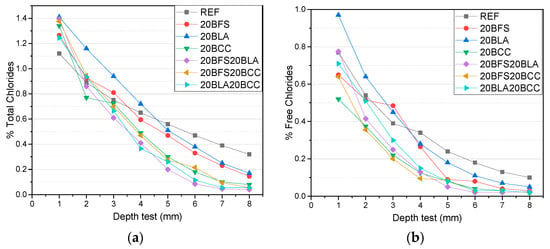
Figure 9.
Chloride profile of the tested mortar samples. (a) Total chloride; (b) Free chloride.
As the depth of analysis increases, the chloride content of mortars decreases. The compound mortar exhibits a significantly higher chloride concentration in the first layer, which then diminishes rapidly. This behavior in the chloride profile is expected, according to the literature, since the decrease follows an exponential function over time [47]. All tested mortars exhibit a lower percentage of total chlorides beyond 5 mm and a reduced percentage of free chlorides beyond 4 mm. All binary and ternary blends outperform the reference mortar in terms of chloride diffusion behavior. At depths less than 8 mm, total chloride values for the BCC binary blend and all the ternary blends are below 0.1 wt.%. The sustainable compositions, whether binary or ternary, show free chloride contents considerably lower than 0.1 wt.%, compared to 0.1 wt.% for the reference sample. Given the minimal radius of Cl-, chloride ions can easily permeate the small cavity in the mortar’s pores, leading to the dissolution of Ca(OH)2 and reacting with aluminates to form calcium chloroaluminate hydrates or Friedel’s salt (C3A·CaCl2·10H2O), where Cl- becomes chemically bound. However, this crystalline phase can result in expansion, softening of the concrete, and increased porosity [15,48]. The robust performance against chloride diffusion is particularly noteworthy, as sustainable compositions with reduced cement content have been investigated, achieving reductions of up to 40% through the incorporation of supplementary cementitious materials (SCMs), such as waste materials (BFS and BLA) or abundant and economical options like BCC.
Figure 10 illustrates the relationship between free chloride content and total chloride content for each mix design. In all instances, this correlation exceeds 0.9.
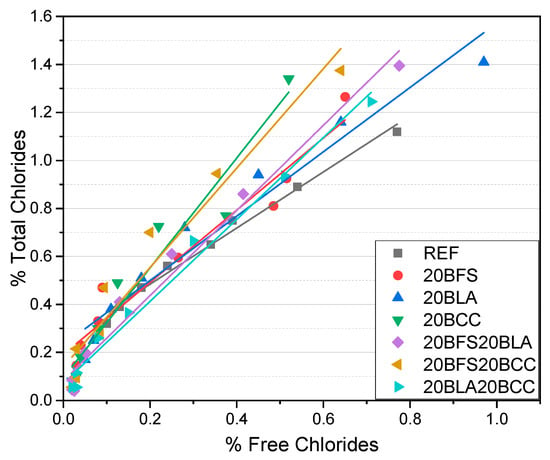
Figure 10.
Correlation between free chloride content and total chloride content.
The slope of the line derived from plotting free chlorides (on the x-axis) against total chlorides (on the y-axis) is correlated with the chloride binding capacity (R) [31]. Table 4 displays the chloride binding capacity, R, of all mix designs, where α represents the slope in the graph of free chlorides (%) versus total chlorides (%).

Table 4.
Values obtained for chloride binding capacity, R, in each mix design.
Replacing cement with supplementary cementitious materials (SCMs) enhances the binding capacity across all mix designs. The highest binding capacity was observed in the mortar containing 20% of BCC. Garcia et al. (2020) [31] reported an increase in the chloride binding capacity when 8% wt. of cement was substituted with metakaolin, attributing this enhancement to the formation of a greater amount of hydrated aluminate. The chemical composition of binders (Table 1) reveals that BCC contains 29.32% of Al2O3. This substantial oxide content may have contributed to the observed increase in binding capacity.
3.1.6. Carbonatation
In composite materials, various factors affect the carbonation rate, including permeability, temperature, and moisture content. In the surrounding environment, humidity and CO2 content are key contributors [49,50]. Under normal conditions, atmospheric CO2 levels range from 0.03% to 1%. However, to expedite testing, many studies utilize higher gas concentrations [51]. Figure 11 illustrates some of the mortars tested after 70 days in a carbonation chamber with 3% CO2. The color difference is evident between the carbonated area at the edges and the fuchsia-colored non-carbonated zone in the center, which appears after the sample is treated with a phenolphthalein solution.

Figure 11.
CO2 penetration depth after 70 days in the carbonatation chamber.
Table 5 displays the carbonation depth values obtained after 7, 28, and 70 days at a CO2 concentration of 3%.

Table 5.
Mean depth of carbonation over time.
The specimens measured after 7 days exhibited no signs of carbonation. Following a 28-day exposure in a CO2 chamber, only the 20BFS20BLA mix showed a carbonation depth of 2.25 mm. This mix demonstrated higher electrical resistivity compared to the other mortars tested, indicating reduced chloride migration and diffusion. In the final measurement taken at 70 days, all mortar mixes that included 40% cement replacement and 20BCC displayed some degree of carbonation.
The carbonation test was conducted using a phenolphthalein solution, which indicates pH levels by remaining colorless in low-pH environments (below 9.5) and acidic conditions while turning pink to deep red in highly alkaline conditions (pH ≥ 9.5). It is noteworthy that portlandite, which serves as an alkaline reserve against carbonation, only forms during cement hydration. In the case of ternary samples, 40% of the cement is replaced by sustainable supplementary cementitious materials. In composite mortars, the pozzolanic reaction consumes the calcium hydroxide produced during cement hydration. Since calcium hydroxide is a strong base, its consumption through the pozzolanic reaction with silica and water results in a lower pH for the mortar, leading to quicker color changes. Furthermore, the portlandite that is not utilized in the pozzolanic reaction can be carbonated in the presence of CO2, resulting in the formation of calcium carbonate. When the alkaline reserve (Ca(OH)2) is depleted, the carbonation of composite mortars results in a change in pH rather than an increase in permeability, as observed in other tests [52].
In the study conducted by Cuenca-Moyano et al. (2023) [53], the incorporation of biomass bottom ash into concrete was found to enhance carbonation as the level of cement replacement increased. This phenomenon was linked to the inherent properties of the material and its porous structure, which facilitates the penetration of CO2. Similarly, Bosque et al. [54] investigated carbonation in composites where cement was partially replaced with supplementary cementitious materials (SCMs), utilizing up to 25% fired clay waste. In these ecological composites, the mean carbonation depth showed a slight increase, primarily attributed to the lower portlandite content resulting from the pozzolanic reaction. Furthermore, this behavior may be influenced by the generally longer curing time required by pozzolanic materials compared to Portland cement, potentially leading to inadequate curing and increased pore connectivity, depending on the type and amount used.
4. Conclusions
- Binary and ternary mortars containing 20 to 40 wt.% of waste materials (BFS, BLA, BCC) demonstrate mechanical performance comparable to the reference mix, exceeding the required strength of 42.5 MPa at 28 days.
- All formulations evaluated show significantly higher electrical resistivity compared to the reference mix, particularly the ternary blends, suggesting a reduction in porosity.
- Ternary blends with a 40% replacement rate exhibited the best resistance to chloride ingress, with diffusion and migration coefficients up to four times lower than those of the reference material.
- Binary mixes with a 20% replacement rate exhibited a reduction in diffusion and migration coefficients of approximately half compared to the reference mix.
- BFS and BLA binary mixes displayed superior carbonation resistance, even outperforming the reference material.
- Ternary mixes showed diminished carbonation resistance due to the higher levels of cement replacement and significant pozzolanic activity, particularly from calcined clay, which results in lower portlandite content and reduced alkaline reserve.
Author Contributions
Conceptualization, L.H.P.S., J.R.T. and F.F.G.d.P.; methodology, L.H.P.S. and M.A.d.l.R.; validation, M.A.d.l.R., A.K. and A.M.T.; formal analysis, L.H.P.S., M.A.d.l.R. and A.K.; investigation, L.H.P.S., J.R.T., F.F.G.d.P. and M.A.d.l.R.; resources, A.K., J.H.d.S.R. and A.M.T.; data curation, L.H.P.S.; writing—original draft preparation, L.H.P.S., M.A.d.l.R. and A.K.; supervision, M.A.d.l.R., A.K. and A.M.T.; project administration, A.K.; funding acquisition, A.K., J.H.d.S.R. and A.M.T. All authors have read and agreed to the published version of the manuscript.
Funding
This research was funded by Coordenação de Aperfeiçoamento de Pessoal de Nível Superior—Brazil (CAPES) [grant numbers 001, 88881.690588/2022-01, 88881.691143/2022] and Conselho Nacional de Desenvolvimento Científico e Tecnológico [grant number 306069/2023-4].
Data Availability Statement
Data will be made available on request.
Conflicts of Interest
The authors declare no conflicts of interest.
Abbreviations
The following abbreviations are used in this manuscript:
| MDPI | Multidisciplinary Digital Publishing Institute |
| BCC | Brazilian Calcined Clay |
| BFS | Blast Furnace Slag |
| BLA | Bamboo Leaf Ash |
| CAPES | Coordenação de Aperfeiçoamento de Pessoal de Nível Superior |
| CC | Calcined Clay |
| CSH | Calcium Silicate Hydrate |
| IFSP | Federal Institute of Education, Science and Technology |
| OPC | Ordinary Portland Cement |
| PP | Pumice Powder |
| REF | Reference |
| SCM | Supplementary Cementitious Materials |
| sd | Standard Deviation |
| SSA | Specific Surface Area |
| UNB | University of Brasília |
| XRF | X-ray fluorescence |
References
- Jaramillo, A.; González, C.; Lopez, N.; Puga, K.L.N. Estudio experimental en morteros con ceniza de hoja de bambú como material cementante suplementario. Rev. Iniciación Científica 2023, 9, 59–65. [Google Scholar] [CrossRef]
- Rodier, L.; Villar-Cociña, E.; Ballesteros, J.M.; Junior, H.S. Potential use of sugarcane bagasse and bamboo leaf ashes for elaboration of green cementitious materials. J. Clean. Prod. 2019, 231, 54–63. [Google Scholar] [CrossRef]
- Latini, A.O.; Dias, L.D.; Silva, B.R.; Souza, L.M. Advancements in bamboo preservative solutions for sustainable construction in Brazil. Int. J. Environ. Sci. Technol. 2024, 21, 8207–8210. [Google Scholar] [CrossRef]
- Silva, L.H.P.; Nehring, V.; de Paiva, F.F.G.; Tamashiro, J.R.; Galvín, A.P.; López-Uceda, A.; Kinoshita, A. Use of blast furnace slag in cementitious materials for pavements—Systematic literature review and eco-efficiency. Sustain. Chem. Pharm. 2023, 33, 101030. [Google Scholar] [CrossRef]
- Adesanya, D.A.; Raheem, A.A. Development of corn cob ash blended cement. Constr. Build. Mater. 2009, 23, 347–352. [Google Scholar] [CrossRef]
- Oliveira, F.T.; Moreira, C.; da Silva Rêgo, J.H.; Capuzzo, V.M.S. Influence of the Limestone Type on the Compression Strength of LC3 Cements. In Proceedings of the International Conference of Sustainable Production and Use of Cement and Concrete, Villa Clara, Cuba, 23–30 June 2019; pp. 39–45. [Google Scholar] [CrossRef]
- Moreira, C. Efeitos do Teor de Gipsita na Microestrutura das Pastas de Cimento LC. Ph.D. Thesis, Universidade de Brasília, Brasília, Brazil, 2020. [Google Scholar]
- Albuquerque, R.T.O.; de Andrade Lima, N.L. Adições minerais ao concreto: Melhores propriedades, maior economia e mais sustentabilidade. Rev. Interdiscip. Da Univ. Veiga Almeida. 2014, 11, 57–64. [Google Scholar]
- Xuan, M.; Bae, S.C.; Kwon, S.-J.; Wang, X.-Y. Sustainability enhancement of calcined clay and limestone powder hybrid ultra-high-performance concrete using belite-rich Portland cement. Constr. Build. Mater. 2022, 351, 128932. [Google Scholar] [CrossRef]
- Jamhiri, B. Evaluation of Pozzolan-Lime Stabilization on Physical Properties of Fine Sandy Engineering Fills. Konya J. Eng. Sci. 2020, 8, 80–90. [Google Scholar] [CrossRef]
- Maier, M.; Sposito, R.; Beuntner, N.; Thienel, K.-C. Particle characteristics of calcined clays and limestone and their impact on early hydration and sulfate demand of blended cement. Cem. Concr. Res. 2022, 154, 106736. [Google Scholar] [CrossRef]
- Mohammed, A.A.; Nahazanan, H.; Nasir, N.A.M.; Huseien, G.F.; Saad, A.H. Calcium-Based Binders in Concrete or Soil Stabilization: Challenges, Problems, and Calcined Clay as Partial Replacement to Produce Low-Carbon Cement. Materials 2023, 16, 2020. [Google Scholar] [CrossRef]
- Zhao, Y.; Gao, J.; Xu, Z.; Li, S.; Luo, X.; Chen, G. Long-term hydration and microstructure evolution of blended cement containing ground granulated blast furnace slag and waste clay brick. Cem. Concr. Compos. 2021, 118, 103982. [Google Scholar] [CrossRef]
- Ukpata, J.O.; Basheer, P.A.M.; Black, L. Expansion of CEM I and slag-blended cement mortars exposed to combined chloride-sulphate environments. Cem. Concr. Res. 2019, 123, 105794. [Google Scholar] [CrossRef]
- Aziz, M.A.E.; Aleem, S.A.E.; Heikal, M.; Didamony, H.E. Hydration and durability of sulphate-resisting and slag cement blends in Caron’s Lake water. Cem. Concr. Res. 2005, 35, 1592–1600. [Google Scholar] [CrossRef]
- Silva, L.H.P.; Tamashiro, J.R.; de Paiva, F.F.G.; Santos, L.F.D.; Teixeira, S.R.; Kinoshita, A.; Antunes, P.A. Bamboo leaf ash for use as mineral addition with Portland cement. J. Build. Eng. 2021, 42, 102769. [Google Scholar] [CrossRef]
- Moraes, M.J.B.J.B.; Moraes, J.C.B.C.B.; Tashima, M.M.M.; Akasaki, J.L.L.; Soriano, L.; Borrachero, M.V.V.; Payá, J. Production of bamboo leaf ash by auto-combustion for pozzolanic and sustainable use in cementitious matrices. Constr. Build. Mater. 2019, 208, 369–380. [Google Scholar] [CrossRef]
- Villar-Cociña, E.; Frías, M.; Savastano, H.; Rodier, L.; de Rojas, M.I.S.; del Bosque, I.F.S.; Medina, C. Quantitative Comparison of Binary Mix of Agro-Industrial Pozzolanic Additions for Elaborating Ternary Cements: Kinetic Parameters. Materials 2021, 14, 2944. [Google Scholar] [CrossRef]
- UNE-EN 197-1; Composition, Specifications and Conformity Criteria for Common Cements. European Committee for Standardization: Brussels, Belgium, 2011.
- ASTM C618-19; Standard Specification for Coal Fly Ash and Raw or Calcined Natural Pozzolan for Use in Concrete. ASTM International: West Conshohocken, PA, USA, 2019.
- Mohammed, S.; Safiullah, O. Optimization of the SO3 content of an Algerian Portland cement: Study on the effect of various amounts of gypsum on cement properties. Constr. Build. Mater. 2018, 164, 362–370. [Google Scholar] [CrossRef]
- ASTM C989/C989M-18a; Standard Specification for Slag Cement for Use in Concrete and Mortars. ASTM International: West Conshohocken, PA, USA, 2018. [CrossRef]
- Chen, K.; Wu, D.; Yi, M.; Cai, Q.; Zhang, Z. Mechanical and durability properties of metakaolin blended with slag geopolymer mortars used for pavement repair. Constr. Build. Mater. 2021, 281, 122566. [Google Scholar] [CrossRef]
- Hakeem, I.Y.; Agwa, I.S.; Tayeh, B.A.; Mahmoud, H.A.-E. Effect of using a combination of rice husk and olive waste ashes on high-strength concrete properties. Case Stud. Constr. Mater. 2022, 17, e01486. [Google Scholar] [CrossRef]
- Cociña, E.V.; Savastano, H.; Rodier, L.; Lefran, M.; Frías, M. Pozzolanic Characterization of Cuban Bamboo Leaf Ash: Calcining Temperature and Kinetic Parameters. Waste Biomass Valorization 2016, 9, 691–699. [Google Scholar] [CrossRef]
- Talero, R. Qualitative Analysis of Natural Pozzolanas, Fly Ashes, and Blast Furnace Slags by XRD. J. Mater. Civ. Eng. 1990, 2, 106–115. [Google Scholar] [CrossRef]
- UNE-EN 196-1; Methods of Testing Cement—Part 1: Determination of Strength. European Committee for Standardization: Brussels, Belgium, 2018.
- Silva, L.H.P.S.; Paiva, F.F.G.d.; Tamashiro, J.R.; Kinoshita, A. Potential of bamboo leaf ash as supplementary binder materials—A systematic literature review. J. Build. Eng. 2023, 71, 106547. [Google Scholar] [CrossRef]
- UNE-EN 934-2; Admixtures for Concrete, Mortar and Grout—Part 2: Concrete Admixtures—Definitions, Requirements, Conformity, Marking and Labelling. European Committee for Standardization: Brussels, Belgium, 2002.
- UNE-EN 83988-1; Concrete Durability. Test Methods. Determination of the Electrical Resistivity. Part 1: Direct Test (Reference Test). European Committee for Standardization: Brussels, Belgium, 2008.
- Garcia, R.; Henao, N.; De la Rubia, M.A.; Moragues, A.; Fernandez, J. Early contributing nanostructured cementitious matrix designs: Benefits in durable features at early ages. Constr. Build. Mater. 2020, 241, 117941. [Google Scholar] [CrossRef]
- NT Build 492; Concrete, Mortar and Cement-Based Repair Materials: Chloride Migration Coefficient from Non-Steady-State Migration Experiments. Nordic Cooperation: Espoo, Finland, 1999.
- Castellote, M.; Andrade, C. RILEM TC 178-TMC: “Testing and modelling chloride penetration in concrete” Round-Robin test on chloride analysis in concrete—Part II: Analysis of water soluble chloride content. Mater. Struct. 2001, 34, 589–598. [Google Scholar] [CrossRef]
- UNE-EN 14629; Productos and Systems for the Protection and Repair of Concrete Strutures. Test Methods. Determination of Cloride Content in Hardened Concrete. European Committee for Standardization: Brussels, Belgium, 2007.
- NT Build 443; Concrete, Hardened: Accelerated Chloride Penetration. Nordic Cooperation: Espoo Finland, 1995.
- UNE-EN 12390-12; Testing Hardened Concrete—Part 12: Determination of the Carbonation Resistance of Concrete—Accelerated Carbonation Method. European Committee for Standardization: Brussels, Belgium, 2020.
- Abebaw, G.; Bewket, B.; Getahun, S. Experimental Investigation on Effect of Partial Replacement of Cement with Bamboo Leaf Ash on Concrete Property. Adv. Civ. Eng. 2021, 2021, 6468444. [Google Scholar] [CrossRef]
- Gyurkó, Z.; Nemes, R. Static Hardness Testing of Cement Mortars Containing Different Types of Recycled Construction Waste Powders. Solids 2021, 2, 331–340. [Google Scholar] [CrossRef]
- Sujjavanich, S.; Suwanvitaya, P.; Chaysuwan, D.; Heness, G. Synergistic effect of metakaolin and fly ash on properties of concrete. Constr. Build. Mater. 2017, 155, 830–837. [Google Scholar] [CrossRef]
- Khatib, J.M.; Hibbert, J.J. Selected engineering properties of concrete incorporating slag and metakaolin. Constr. Build. Mater. 2005, 19, 460–472. [Google Scholar] [CrossRef]
- Adem, H.H.; Cherkos, F.D. Analyzing the Mechanical, Durability, and Microstructural Impact of Partial Cement Replacement with Pumice Powder and Bamboo Leaf Ash in Concrete. Adv. Civ. Eng. 2024, 2024, 5119850. [Google Scholar] [CrossRef]
- García, R.; Reyes, E.; Villanueva, P.; de la Rubia, M.; Fernández, J.; Moragues, A. Service Life and Early Age Durability Enhancement due to Combined Metakaolin and Nanosilica in Mortars for Marine Applications. Materials 2020, 13, 1169. [Google Scholar] [CrossRef]
- McCarter, W.J.; Chrisp, T.M.; Starrs, G.; Adamson, A.; Basheer, P.A.M.; Nanukuttan, S.V.; Srinivasan, S.; Green, C. Characterization of physio-chemical processes and hydration kinetics in concretes containing supplementary cementitious materials using electrical property measurements. Cem. Concr. Res. 2013, 50, 26–33. [Google Scholar] [CrossRef]
- Sanjuán, M.A.; Argiz, C.; Gálvez, J.C.; Reyes, E. Combined effect of nano-SiO2 and nano-Fe2O3 on compressive strength, flexural strength, porosity and electrical resistivity in cement mortars. Mater. Construcción 2018, 68, 150. [Google Scholar] [CrossRef]
- Noushini, A.; Nguyen, Q.D.; Castel, A. Assessing alkali-activated concrete performance in chloride environments using NT Build 492. Mater. Struct. 2021, 54, 57. [Google Scholar] [CrossRef]
- Maes, M.; Gruyaert, E.; De Belie, N. Resistance of concrete with blast-furnace slag against chlorides, investigated by comparing chloride profiles after migration and diffusion. Mater. Struct. 2013, 46, 89–103. [Google Scholar] [CrossRef]
- Pack, S.-W.; Jung, M.-S.; Song, H.-W.; Kim, S.-H.; Ann, K.Y. Prediction of time dependent chloride transport in concrete structures exposed to a marine environment. Cem. Concr. Res. 2010, 40, 302–312. [Google Scholar] [CrossRef]
- Heikal, M.; Zaki, M.E.A.; Ibrahim, S.M. Preparation, physico-mechanical characteristics and durability of eco-alkali-activated binder from blast-furnace slag, cement kiln-by-pass dust and microsilica ternary system. Constr. Build. Mater. 2020, 260, 119947. [Google Scholar] [CrossRef]
- Wang, D.; Noguchi, T.; Nozaki, T.; Higo, Y. Investigation of the carbonation performance of cement-based materials under high temperatures. Constr. Build. Mater. 2021, 272, 121634. [Google Scholar] [CrossRef]
- Silva, R.V.; Neves, R.; de Brito, J.; Dhir, R.K. Carbonation behaviour of recycled aggregate concrete. Cem. Concr. Compos. 2015, 62, 22–32. [Google Scholar] [CrossRef]
- Pauletti, C.; Possan, E.; Molin, D.C.C.D. Accelerated carbonation: State-of-the art of the research in Brazil. Ambiente Construído 2007, 7, 7–20. [Google Scholar]
- Alonso-Domínguez, D.; Álvarez-Serrano, I.; Reyes, E.; Moragues, A. New mortars fabricated by electrostatic dry deposition of nano and microsilica additions: Enhanced properties. Constr. Build. Mater. 2017, 135, 186–193. [Google Scholar] [CrossRef]
- Cuenca-Moyano, G.M.; Cabrera, M.; López-Alonso, M.; Martínez-Echevarría, M.J.; Agrela, F.; Rosales, J. Design of lightweight concrete with olive biomass bottom ash for use in buildings. J. Build. Eng. 2023, 69, 106289. [Google Scholar] [CrossRef]
- Sáez del Bosque, I.F.; Van den Heede, P.; De Belie, N.; Sánchez de Rojas, M.I.; Medina, C. Carbonation of concrete with construction and demolition waste based recycled aggregates and cement with recycled content. Constr. Build. Mater. 2020, 234, 117336. [Google Scholar] [CrossRef]
Disclaimer/Publisher’s Note: The statements, opinions and data contained in all publications are solely those of the individual author(s) and contributor(s) and not of MDPI and/or the editor(s). MDPI and/or the editor(s) disclaim responsibility for any injury to people or property resulting from any ideas, methods, instructions or products referred to in the content. |
© 2025 by the authors. Licensee MDPI, Basel, Switzerland. This article is an open access article distributed under the terms and conditions of the Creative Commons Attribution (CC BY) license (https://creativecommons.org/licenses/by/4.0/).